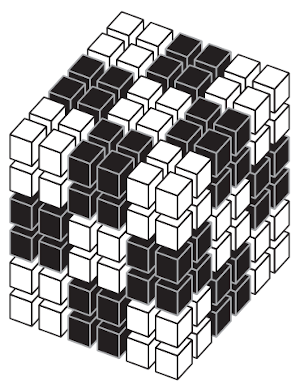
At age 7, F.W. de Bruijn found himself unable to pack a box measuring 6 × 6 × 6 quite completely with bricks measuring 1 × 2 × 4. The box had volume 216, so it might be expected to accommodate exactly 27 bricks, but he found there was no way to pack more than 26.
He mentioned this to his father, who happened to be mathematician Nicolaas Govert de Bruijn, and Nicolaas found that a “harmonic brick” (one in which the length of each side is a multiple of the next smaller side length) can be packed efficiently only into a box whose dimensions are multiples of the brick’s dimensions.
This can seen intuitively by imagining the 6 × 6 × 6 box filled with small colored cubes as shown here. No matter where it’s placed, each 1 × 2 × 4 brick must now displace an equal number of white and black cubes. But the box contains 112 white cubes and 104 black ones. So the task is impossible.
(Nicholas G. de Bruijn, “Filling Boxes With Bricks,” American Mathematical Monthly 76:1 [1969], 37-40.)
